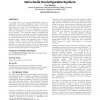Free Online Productivity Tools
i2Speak
i2Symbol
i2OCR
iTex2Img
iWeb2Print
iWeb2Shot
i2Type
iPdf2Split
iPdf2Merge
i2Bopomofo
i2Arabic
i2Style
i2Image
i2PDF
iLatex2Rtf
Sci2ools
107
click to vote
GLVLSI
2003
IEEE
2003
IEEE
Exploiting multiple functionality for nano-scale reconfigurable systems
It is likely that it will become increasingly difficult to manufacture the complex, heterogeneous logic structures that characterise current reconfigurable logic systems. As a result, these systems may come to be characterised by vast arrays of largely identical devices that are differentiated via postfabrication configuration – but only if low-overhead configuration can be achieved. Two simulation studies are presented that describe some ideas for achieving low-overhead reconfigurability in systems built from nano-scale components. The first is based on variable-threshold devices built from thin-body double gate transistors while a second, more speculative idea is based on recently identified resonant tunneling behaviour in carbon nanotubes. Various logic functions can be configured via the application of a simple bias voltage. Further, two approaches to the issue of generating the required bias voltages based on RTD devices and chalcogenide films are briefly explored. Categories a...
Related Content
| Added | 04 Jul 2010 |
| Updated | 04 Jul 2010 |
| Type | Conference |
| Year | 2003 |
| Where | GLVLSI |
| Authors | Paul Beckett |
Comments (0)

